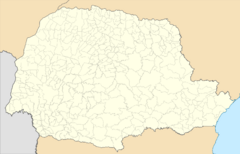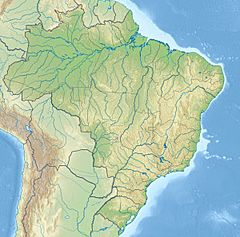Guaíra Falls facts for kids
Quick facts for kids Guairá Falls |
|
|---|---|

The falls prior to submersion in 1982.
|
|
| Lua error in Module:Infobox_mapframe at line 185: attempt to index field 'wikibase' (a nil value). | |
| Location | Border between Paraguay and Brazil |
| Coordinates | 24°04′23″S 54°17′01″W / 24.07306°S 54.28361°W |
| Type | block |
| Total height | 114 m (375 ft) |
| Number of drops | 19 total, 7 primary |
| Watercourse | Paraná River |
| Average flow rate |
13,000 m3/s (470,000 cu ft/s) |
The Guairá Falls (called Saltos del Guairá in Spanish and Salto das Sete Quedas do Guaíra in Portuguese) were a massive group of waterfalls. They were located on the Paraná River, right on the border between Paraguay and Brazil. These incredible falls disappeared in 1982. They were covered by the huge lake created when the Itaipu Dam was built.
Guairá Falls had one of the largest water flows of any waterfall on Earth at that time. The amount of water rushing over them was enormous, though different reports give slightly different numbers.
The falls were made up of 18 separate drops, grouped into seven main sections. This is why their Portuguese name, Sete Quedas, means "Seven Falls." They were near the Brazilian town of Guaíra, Paraná and the Paraguayan city of Salto de Guairá. At this spot, the Paraná River was squeezed into a very narrow gorge. The river, which was about 380 m (1,250 ft) wide, suddenly became only 61 m (200 ft) wide.
The total height of all the falls combined was about 114 m (375 ft). The tallest single drop was about 40 m (130 ft) high. The powerful sound of the water crashing down was so loud that you could hear it from as far as 32 km (20 mi) away!
Why the Falls Disappeared
The Guairá Falls were a popular place for tourists and local people to visit. But they were completely covered by the artificial lake formed by the Itaipu Dam. This happened when the dam was finished in 1982. The decision to build the dam was made in 1973 through an agreement between Paraguay and Brazil. This agreement helped the two countries work together, especially since both had claimed ownership of the falls.
As the Itaipu Dam was being built, thousands of people rushed to see the falls one last time. A sad event happened on January 17, 1982. A hanging footbridge that offered a great view of the falls broke. Dozens of tourists died in this accident.
A famous Brazilian poet named Carlos Drummond de Andrade wrote a poem about how sad he was that the falls were being destroyed. This poem was printed very large in a newspaper:
Here seven visions, seven liquid sculptures
vanished through the computerized calculations
of a country ceasing to be human
in order to become a chilly corporation, nothing more.
A movement becomes a dam.
—Carlos Drummond de Andrade, "Farewell to Seven Falls" (excerpt, translated from the Portuguese)
Before the water completely covered the falls, hundreds of people gathered for a special event. They took part in a guarup, which is an indigenous ritual. It was a way to remember the falls before they vanished.
The falls were covered very quickly, in just 14 days. This happened during the rainy season when the Paraná River was already very high. By October 27, 1982, the lake was full, and the falls were gone. Only a small part of the rock face could be seen during very dry years.
The director of the company that built the dam said something interesting about the falls disappearing. He was quoted saying, "We're not destroying Seven Falls. We're just going to transfer it to Itaipu Dam, whose spillway will be a substitute for [the falls'] beauty."
See also
 In Spanish: Saltos del Guairá para niños
In Spanish: Saltos del Guairá para niños
- List of waterfalls by flow rate



